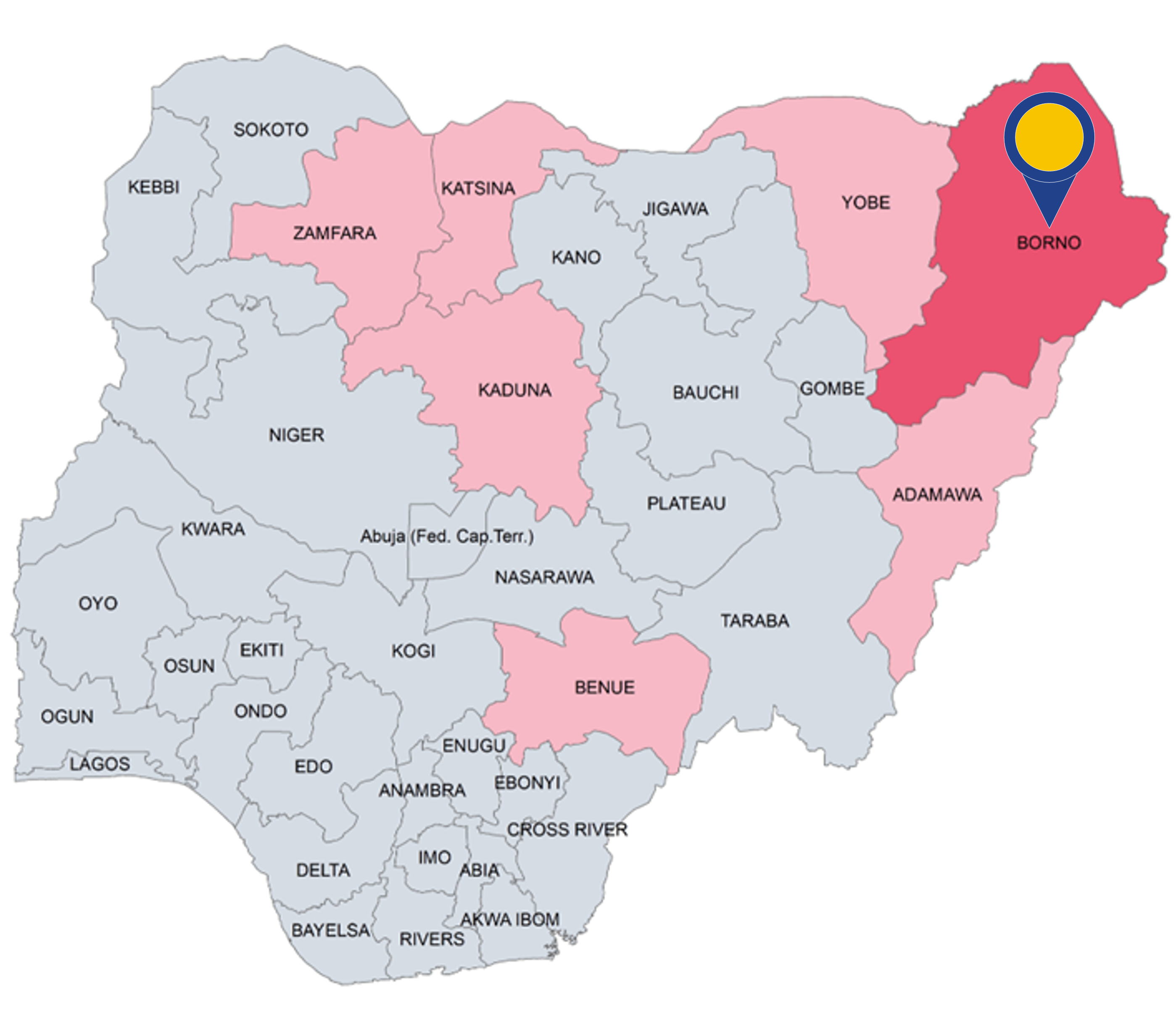Borno state is composed of 27 LGAs and its capital is Maiduguri city. The state’s estimated population was 5 860 183 in 2016.

Borno state was the birthplace of Boko Haram in 2002 and, together with Yobe and Adamawa, the area where the group’s activities are mostly concentrated. The main actors in this conflict are, on one hand, Boko Haram/JAS and ISWAP and, on the other hand, the Nigerian security forces. There are also community militia groups, particularly CJTF, active in Borno state. Although Boko Haram has been pushed by Nigerian military forces out of several states in the North-East region, it continues to retain control over some villages and pockets of territory in Borno and taxes residents. The introduction of the strategy of ‘super camps’, in which the soldiers were withdrawn from remote communities and retreated in their fortified camps after curfew, has succeeded in reducing security forces’ casualties; however, in the evenings, ISWAP appears to have close to free rein in the countryside and smaller towns. In 2020, it was further observed that cooperation and collaboration between (motorcycle) bandits and Boko Haram factions continued in a number of northern states, including Borno state.
Borno was the most affected state with the number of security incidents reported by ACLED in 2020 nearly doubling compared to data of 2019. Mostly insurgents or security officers were reported as fatalities, however, fatalities of civilians were also recorded. The main cause of civilian fatalities was violence by Boko Haram and counter activities by the Nigerian security forces. During attacks against military targets, Boko Haram has indiscriminately shot against civilians resulting in multiple casualties. Boko Haram has further continued to launch deadly suicide attacks, to attack and loot villages, burn houses and abduct civilians, mostly women and children. In 2020, illegal checkpoints on roads, planting of IEDs on the main supply routes, road attacks or ambushes followed by abductions of civilians by non-state armed forces dressed in military uniforms, were also reported. Many survivors of such illegal roadblocks have given accounts of how the insurgents target security personnel, humanitarian workers, or non-Muslims. UN humanitarian facilities and Christian communities have also been attacked by Boko Haram. Furthermore, civilians have reportedly been killed as a result of airstrikes conducted by the Nigerian forces against Boko Haram targets. Community militia groups were also reported to have inflicted harm against civilians. Criminal activities and civil unrest also took place in the region. In February 2021, Boko Haram launched a heavy attack against residents in several locations within Maiduguri city, resulting in many civilian casualties. The attack involved an assault team and volleys of mortars and it was the first attack in years which broke the tight security of the city.
Furthermore, there have been reports of incidents involving both civilian and military casualties from landmines and a range of other locally produced explosive devices planted by Boko Haram in the northeast of the country, particularly in Borno, Yobe, and Adamawa states.
During 2020, ACLED reported a total of 582 security incidents (362 battles, 148 remote violence/explosion, 107 cases of violence against civilians, 1 incident of riot) in Borno state (average of 11.1 security incident per week). Security incidents took place in 24 out of 27 LGAs, with the largest overall number (64) being recorded in the LGA of Gwoza.
The abovementioned security incidents resulted in 3 168 deaths. Compared to the estimated population in the state, this represents approximately 54 fatalities per 100 000 inhabitants.
From 1 January to 30 April 2021, ACLED reported a total of 195 security incidents (119 battles, 58 incidents of remote violence/explosions, 17 cases of violence against civilians, 1 incident of riots) in Borno state (average of 11.5 security incident per week). These security incidents resulted in 1 304 deaths.
Borno has the highest number of IDPs mounting to 1 603 044 people. It should further be noted that Borno’s three most populous LGAs were not accessible to IOM assessment due to increased hostilities in the areas. Of the IDPs in North-East region, 89 % were displaced within their state of origin. The total number of returnees to Borno state by November 2020 was 724 263. Borno state government's plan to return IDPs to some LGAs witnessing escalating clashes and attacks, has raised concerns of safety and continued access of IDPs to critical assistance and services.
The humanitarian crisis in the north-eastern states of Borno, Adamawa, and Yobe has been described as among the world’s most severe. In northern Borno, new waves of non-state armed groups attacks and clashes with government forces along key supply routes occurred, challenging aid deliveries in certain areas. Following attacks in April 2021 on UN facilities in Damasak, aid operations were temporarily suspended in the area.
|
|
Looking at the indicators, it can be concluded that ‘mere presence’ in the area would not be sufficient to establish a real risk of serious harm under Article 15(c) QD in the state of Borno. However, indiscriminate violence reaches a high level, and, accordingly, a lower level of individual elements is required to show substantial grounds for believing that a civilian, returned to the territory, would face a real risk of serious harm within the meaning of Article 15(c) QD.
|

